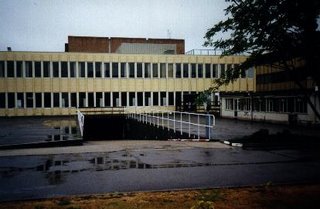 "I could viddy myself very clear, running and running on like very light and mysterious feet, carving the whole face of the creeching world"
"I could viddy myself very clear, running and running on like very light and mysterious feet, carving the whole face of the creeching world"

Classic Trailers - A Clockwork Orange
I watched 'A Clockwork Orange'(Buy A Clockwork Orange from amazon.co.uk here)
Watching it is like watching the seventies refracted through a kaleidoscope. All of the things that we consider to be so emblematic are there but in a slightly different form. Rather than being futuristic, it's contemporary to the time it was made. Kubrick is on record as stating that the locations were drawn from a survey of current architectural journals, catching the possible future as it hatched and then extrapolating its effects. Only three sets were constructed, the rest of the film shot in real buildings and locations.
Witness the Writer's home, with its split level rooms and pine cladding. The chilly clarity of Thamesmead and Brunel University are exaggerated versions of themselves, shot without warmth, the harsh lines and brutal concrete deliberately presented as alienating. The decor of the DeLarge household is high seventies modern, an explosion of plastic and glitter.
 Watching it now, it's like an alternate seventies... Whilst masquerading as a film set in the future, it actually sat very much in its own present. It makes me think of the fact that none of the characters in the film know that they are 'in the future', to them it is merely the present, evidenced by Alex's parents with their archetypal British family set-up of factories and breakfasts. Despite being clad in tinfoil and garnished with moulded plastic, the life of the characters in 'A Clockwork Orange' show that as much as technology advances, many fundamentals of life remain the same. They are typically working class, transplanted as many people were, to the top of a tower poking up into a grey sky. Witness the 'People's Stylings' of the mural at the base of their block.
Watching it now, it's like an alternate seventies... Whilst masquerading as a film set in the future, it actually sat very much in its own present. It makes me think of the fact that none of the characters in the film know that they are 'in the future', to them it is merely the present, evidenced by Alex's parents with their archetypal British family set-up of factories and breakfasts. Despite being clad in tinfoil and garnished with moulded plastic, the life of the characters in 'A Clockwork Orange' show that as much as technology advances, many fundamentals of life remain the same. They are typically working class, transplanted as many people were, to the top of a tower poking up into a grey sky. Witness the 'People's Stylings' of the mural at the base of their block.The Film is set in Avengerland almost, the same chilly country lanes, large villas and futuristic eruptions. There are parts where it veers toward British sitcom staples. The main prison guard, the chaplain and the prison governor could almost be moonlighting from 'Porridge'. There is nothing incompatible in 'A Clockwork Orange' that removes it from the seventies as they actually happened. This must have been evident at the time, with youth culture making it a building block, along with 'Cabaret' for Glam and later Punk.
It's a delicious thought, the idea that out in Thamesmead there actually were little Droogs at play, picking through the wreckage of a country on the wane. In the introduction to his 1974 book 'Soft City',(Buy Soft City from amazon.co.uk here)
 The scenes of Alex's everyday life reminded me of the consumerism of Jerry Cornelius in Michael Moorcock's series of novels and stories. The scene where Alex goes shopping in the reflective, shiny, noisy record shop with its mirrors and plastic and flashing lights, swaggering like the Elizabethan dandy he resembles could have come from Moorcock. The same with decadence of the Korova Milkbar with its achingly cutting edge mixture of sexual abandon and stylised nightclub stylings. If Alex has a close cousin in fiction it's Jerry. Both are led by boredom to escape into aesthetic violence. Both have a shocking hole where their conscience and moral bearings should be. Both enjoy dressing up. The amoral dandy as science fiction hero? I'd love to see more of Alex's everyday life in this hyper seventies.
The scenes of Alex's everyday life reminded me of the consumerism of Jerry Cornelius in Michael Moorcock's series of novels and stories. The scene where Alex goes shopping in the reflective, shiny, noisy record shop with its mirrors and plastic and flashing lights, swaggering like the Elizabethan dandy he resembles could have come from Moorcock. The same with decadence of the Korova Milkbar with its achingly cutting edge mixture of sexual abandon and stylised nightclub stylings. If Alex has a close cousin in fiction it's Jerry. Both are led by boredom to escape into aesthetic violence. Both have a shocking hole where their conscience and moral bearings should be. Both enjoy dressing up. The amoral dandy as science fiction hero? I'd love to see more of Alex's everyday life in this hyper seventies.I also, for the first time, saw the trailer for 'A Clockwork Orange', which can be viewed by clicking the link at the head of this post. It's a blinder, because it manages to put across an idea of the film without giving any firm idea of what it is will actually be seen on viewing it. Almost a lost art now...







